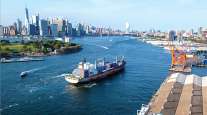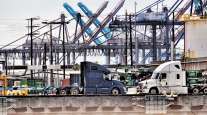Senior Reporter
Supply Chain and Ports Bend but Don’t Break During Holidays

[Stay on top of transportation news: Get TTNews in your inbox.]
As traditional brick-and-mortar and online retailers reported record holiday shopping numbers, experts say the nation’s transportation sector handled the crush of moving hundreds of millions of packages, for the most part on time, and gave consumers their first or second choices for gifts.
“There were some very positive things they, the ports, tried to do. There are also things that obviously they said they were going to do that they haven’t really played out,” IHS Markit Transportation Economist Paul Bingham told Transport Topics. “So, it was somewhat of mixed performance in terms of what was achievable, but probably within the realm of what was possible for the ports.”
During the past 90 days, tens of thousands of empty containers have been moved out of the Port of Los Angeles. Now, port officials say they plan to begin charging shippers a progressively increasing container dwell fee beginning Jan. 30 to encourage them to remove the remaining containers that have sat at the port for nine days or longer.
"We have worked down the imports by about half since we first put into place the threat of a penalty on long, aging containers," says @PortofLA's Gene Seroka on recent changes helping ease the port backlog. pic.twitter.com/9EhPTQnDSG — Squawk Box (@SquawkCNBC) January 4, 2022
“While we have seen significant success reducing import containers on our docks the past two months, too many empty containers are currently sitting on marine terminals,” Port of Los Angeles Executive Director Gene Seroka said. “Just like the import dwell fee, the objective with this empty container program is not to collect fees but to free up valuable space on our docks, clearing the way for more ships and improving fluidity.”
The Los Angeles Board of Harbor Commissioners will consider the program at its Jan. 13 meeting.
If approved, ocean carriers will be charged $100 for an empty container dwelling for nine days, increasing in $100 increments per container per day until the container leaves the terminal.
#POLB and @PortofLA have delayed consideration of the “Container Dwell Fee,” until Jan. 10. Since the program was announced on Oct. 25, the twin ports have seen a combined decline of 35% in cargo on the docks. Read more: https://t.co/4NcesDm8lH — Port of Long Beach (@portoflongbeach) January 4, 2022
Nearby Port of Long Beach temporarily put its fees on hold after both facilities proposed them back in October when nearly 100,000 empty containers were sitting at the ports, clogging the supply chain.
The National Retail Federation and Mastercard SpendingPulse report on the just-completed holiday shopping spree said consumers were spending at record levels in November and December. Even before that, as many heeded the concerns that inventory levels could be low, they bought early.
The final report from NRF is due this month, but preliminary figures show traditional store and online sales may be up 11.5% compared with 2020’s strong numbers. The Washington-based trade association forecast an 8.5% increase and upped its projection after several weeks of solid sales.
The Mastercard SpendingPulse survey forecast holiday shopping increased 8.5% overall year-over-year. The report also said in-store sales were up 8.1%, and e-commerce transactions saw an 11% increase compared with 2020. E-commerce sales now are responsible for more than 20% of consumers’ holiday spending, up from 15% in 2019.
With holiday shopping largely over, the trucking, transportation and logistics industries deal with gift returns. If they take place at 2020’s pace, retailers can expect to see more than $115 billion in products going back to stores and warehouses over the next several weeks. A survey by Inmar Intelligence found that 61% of retailers said they expect 2021’s holiday returns to be even greater than in previous years.

Zomok
“A crucial part of the customer experience and success of retailers is dependent on their ability to process and track returns at an efficient rate. With customers shopping both in-store and online at higher rates this season, this will be an important test for retailers,” Inmar Executive Vice President Rob Zomok said.
Another study, from CBRE-Optoro, on return logistics found that the cost of returns will be 7% more expensive this year compared with 2020, when retailers factor in liquidation losses, transportation costs and discounting their inventory.
Biden administration officials are trumpeting that the possible supply chain crisis that many feared in August, September and October did not come to pass in November and December.
President Joe Biden said bottlenecks are improving, and in late December, retail inventories were up 3% compared with the same period in 2020, and delivery times for FedEx, UPS and the U.S. Postal Service are faster than they were before the COVID-19 pandemic began.

Raimondo
Commerce Secretary Gina Raimondo said the administration’s efforts to loosen up the supply chain have resulted in a 50% drop in congestion compared with November.
IHS Markit’s Bingham lauded port workers for their efforts, especially during the holiday season, but said more needs to be done to rebuild the supply chain.
“An enormous amount of goods have gone through the supply chain,” Bingham said. “The railroads and the intermodal yards and the truckers, you know, everybody contributed to getting items to the store shelves and the doorstep with e-commerce. You know, in a way, you could say the collective supply chain system put out a record-performing year.”
Want more news? Listen to today's daily briefing below or go here for more info:




